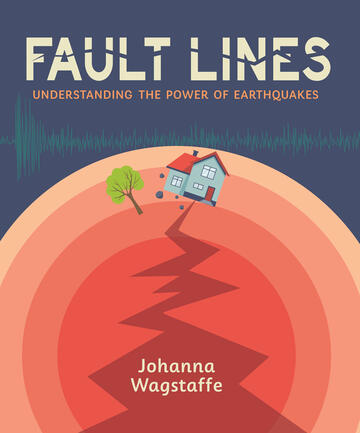
Fault Lines
Understanding the Power of Earthquakes
Drop, cover and hold on.
Description
Earthquakes are a terrifying yet fascinating force of nature. Seismologist Johanna Wagstaffe takes you through her own journey of understanding the earth beneath our feet. Along the way, you’ll learn the science behind what makes the earth rumble and hear from kids around the world who have experienced the wonder, and terror, of an earthquake.
Awards
- Commended, CCBC Best Books for Kids & Teens 2018
- Short-listed, Vancouver Children’s Literature Roundtable Information Book Award 2018
- Short-listed, Young Readers' Choice Book Awards of British Columbia (YRCABC) Red Cedar Book Awards 2019
- Commended, Resource Links, The Year's Best Books 2017
Reviews
"The use of personal stories keeps interest high, and changes in color and typeface, as well as well-placed, colorful art, prevent fatigue. Vocabulary words are flagged in colored italics, and analogies and comparisons heighten clarity. There is even some humor…Thorough, engaging, and accessible. "
- Kirkus Reviews
"Johanna is a gifted communicator, who makes this complex and unsettling topic easy to understand. As she writes, 'Be prepared, not scared'. "
- Ian Hanomansing, host <i>CBC News Now</i>
"The book's layout and use of colorful, contemporary photographs make this an attractive eye-pleaser and will draw readers into the world of seismology. An excellent addition for STEM collections and a usable title in science classrooms. "
- School Library Journal
"Almost every page includes a sharply reproduced photo, while clearly drawn digital drawings, diagrams, and maps also provide insights into the topic. Kids concerned about the topic will find the section chapter on preparedness both useful and reassuring. The conversational tone of the text is engaging, while the interplay of information and narrative will appeal to many readers. A colorful, useful introduction to earthquakes. "
- Booklist
"There are plenty of bright photographs, which aid in understanding the topics. This is an interesting, fun read that will make a wonderful addition to science collections. Useful for teachers looking for motivational and visual texts that will grab students' attention. "
- School Library Connection
“This generously illustrated, cleanly formatted volume uses clear scientific prose to explore earthquakes. ”
- The Horn Book Online
"Fault Lines is a perfectly clear guide to earthquakes and why we should pay attention to them. The science in presented with colourful, easy to understand illustrations, the devastation, through photos from around the world, and the impact on people with person testimonies, including the author herself. Canada's favourite meteorologist and seismologist, Johanna Wagstaffe takes us deep into the earth to see the rumblings beneath our feet and provides a survival guide for when the big one strikes. A must read for anyone living in a earthquake zone. "
- Bob McDonald OC, Host, <i>Quirks & Quarks</i>, Science Correspondent, <i>The National</i>
"Loaded with earthquake facts, stories, and well-selected visuals, Fault Lines: Understanding the Power of Earthquakes will certainly appeal to budding seismologists…The book could easily prove a valuable nonfiction resource for middle and secondary school library collections and support curricular studies of plate tectonics…Highly Recommended. "
- CM Magazine
"What makes the book particularly interesting is Wagstaffe's knowledge of the many earthquakes she has reported for CBC, and frequent sidebars that provide information about specific quakes, including their magnitude, date, and location. Simple graphic art provides clear visual backup for the running text. Excellent photos show the aftermath of many quakes, and illustrate what many people do to prepare for them…This highly recommended title would be an ideal read for Junior and Intermediate level readers interested in this topic."
- Resource Links
"From our earth's core to quakes on other planets, Johanna brings seismology to life through a delightful combination of science and story. Her tales from the frontlines of fault lines are sure to inspire other young scientists to learn more about the wonderful world around them."
- Jennifer Gardy, Microbiologist and author of <i>It's Catching: The Infectious World of Germs and Microbes</i>
"Despite the quantity and complexity of material, the subject matter is clearly presented…The contrast between factual information and the first-hand experiences of children living through a quake is powerful…This is a valuable tool for public libraries as well as junior and middle schools, and a must-read for those living in earthquake zones."
- Canadian Children's Booknews